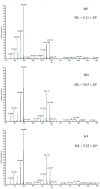Geographical Origin Discrimination of Monofloral Honeys by Direct Analysis in Real Time Ionization-High Resolution Mass Spectrometry (DART-HRMS)
- PMID: 32882806
- PMCID: PMC7556004
- DOI: 10.3390/foods9091205
Geographical Origin Discrimination of Monofloral Honeys by Direct Analysis in Real Time Ionization-High Resolution Mass Spectrometry (DART-HRMS)
Abstract
An untargeted method using direct analysis in real time and high resolution mass spectrometry (DART-HRMS) combined to multivariate statistical analysis was developed for the discrimination of two monofloral (chestnut and acacia) honeys for their geographical origins-i.e., Italy and Portugal for chestnut honey and Italy and China for acacia honey. Principal Component Analysis, used as an unsupervised approach, showed samples of clusterization for chestnut honey samples, while overlapping regions were observed for acacia honeys. Three supervised statistical approaches, such as Principal Components-Linear Discriminant Analysis, Partial Least Squares-Discriminant Analysis and k-nearest neighbors, were tested on the dataset gathered and relevant performances were compared. All tested statistical approaches provided comparable prediction abilities in cross-validation and external validation with mean values falling between 89.2-98.4% for chestnut and between 85.8-95.0% for acacia honey. The results obtained herein indicate the feasibility of the DART-HRMS approach in combination with chemometrics for the rapid authentication of honey's geographical origin.
Keywords: chemometrics; direct analysis in real time (DART); geographical origin; high resolution mass spectrometry (HRMS); monofloral honey.
Conflict of interest statement
The authors declare no conflict of interest.
Figures




References
-
- European Commission Directive 2014/63/EU of The European Parliament and of the Council of 15 May 2014 amending Council Directive 2001/110/EC relating to honey. Off. J. Eur. Comm. 2014;L 164:1–5.
-
- Food and Agriculture Organization of the United Nations Revised Codex Standard for Honey (No. CODEX STAN 12–1981) [(accessed on 25 July 2020)];2001 Available online: www.fao.org/input/download/standards/310/cxs_012e.pdf.
Grants and funding
LinkOut - more resources
Full Text Sources

